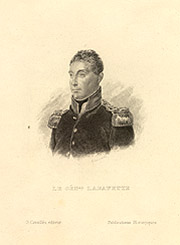 |
SERIES XII. PORTRAITS: JULIEN
Prints of Series XII (Box 9-10) are examples of prints after the Scheffer
type of Series IX and the Gerard type of Series X. The major artist
of the group is Simon Julien (1735-1800), although several prints are related
to the works of artist A. Geille (1802-1843), J. Massard (1740-1822), and
Gabriel Marchand (1755-?). A common characteristic to all these prints
is the military uniform with a plain black neck-band. Some characteristics
are specific to each artist, such as in the case of the Julien type prints,
where the top and fourth button of the coat are undone. In the Geille
type, the top four buttons are undone on the coat and the head is tilted
back. The Massard prints exhibit a different style coat, unbuttoned,
with an embroidered collar. The Massard is more likely to be classed
after the Scheffer type. In the Marchand prints, the coat is also
as in the Massard type, without an embroidered collar. |